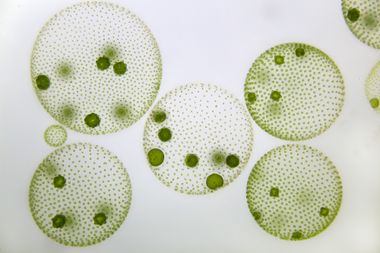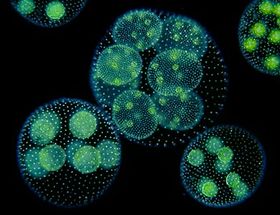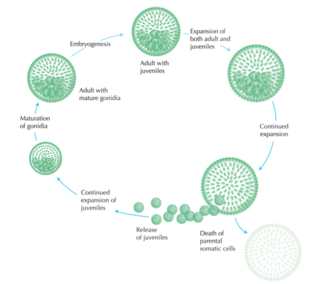Volvox carteri: Difference between revisions
| Line 45: | Line 45: | ||
[[File:vcreproduction.png|thumb|border|320px|left|'''Figure 3'''. Life cycle of ''Volvox carteri'' (?).]] | [[File:vcreproduction.png|thumb|border|320px|left|'''Figure 3'''. Life cycle of ''Volvox carteri'' (?).]] | ||
A unique feature of ''Volvox carteri'' is the microscopic cytoplasmic bridges | A unique structural feature of ''Volvox carteri'' is the formation of microscopic cytoplasmic bridges between somatic cells of the colonies, originating from incomplete cell division during cytokinesis. [1] These connections, which can only be seen by using electron microscopy, allows the movement of small organelles such as mitochondria between cells. As the cells of a colony move further apart, the strands become stretched and therefore smaller, allowing only ribosomes and endoplasmic reticulum to be exchanged among cells. | ||
==Ecology== | ==Ecology== | ||
Revision as of 18:34, 15 April 2018
Classification
Higher Order Taxa
Domain: Eukaryota
Kingdom: Viridiplantae
Phylum: Chlorophyta
Class: Chlorophyceae
Order: Chlamydomonadales
Family: Volvocaceae
Species
Volvox carteri
|
NCBI: [1] |
Description and Significance
Volvox carteri is a motile, multicellular eukaryotic species of green alga comprised of about 2,000 small somatic cells and 16 large reproductive cells (also known as gonidia), which interact in an extracellular matrix to form hollow, spherical colonies. [5][7] It can be found abundantly worldwide in freshwater ponds, lakes, and even some large puddles. The biflagellate characteristic of somatic cells allows V. carteri to move in its aqueous environment in order to adjust the amount of sunlight its photosynthetic cells receive.
Studies of green algae have provided a sufficient amount of information regarding the photosynthesis and biochemical processes of various plant species, proving Volvox aureus to be a valuable model system in ecological studies. [8]
Genome Structure
The Volvox carteri genome was first sequenced in 2010.[6] It had generated interest as a model system to examine the evolution of multicellularity and genomic complexity associated with such a phenomenon. The number of chromosomes that composes the nuclear genome of V. carteri is unestablished; some sources indicate the identification of up to 19 distinct linkage groups, while others find just 14.[5][6] A number of genome characteristics have been defined, however. The nuclear genome is 138 Mbp long and 18% coding, with a GC content of 56%.[5]
A number of papers investigating the evolution of complexity and multicellularity compare the V. carteri genome to a related member of the Volvocine algae family, Chlamydomonas reinhardtii. Relative to the other species in the family, these two organisms are as far apart evolutionarily as possible; C. reinhardtii is simpler and unicellular. Though sequencing both of their genomes has given us insights into their evolutionary history, interest in an examination of genomes of intermediate species has been demonstrated.[6]
Cell Structure, Metabolism and Life Cycle
Interesting features of cell structure; how it gains energy; what important molecules it produces.
A unique structural feature of Volvox carteri is the formation of microscopic cytoplasmic bridges between somatic cells of the colonies, originating from incomplete cell division during cytokinesis. [1] These connections, which can only be seen by using electron microscopy, allows the movement of small organelles such as mitochondria between cells. As the cells of a colony move further apart, the strands become stretched and therefore smaller, allowing only ribosomes and endoplasmic reticulum to be exchanged among cells.
Ecology
Habitat; symbiosis; biogeochemical significance; contributions to environment.
If relevant, how does this organism cause disease? Human, animal, plant hosts? Virulence factors, as well as patient symptoms.
References
Authors
Page authored by Madison Fiegl and JD French, students of Prof. Jay Lennon at Indiana University.



